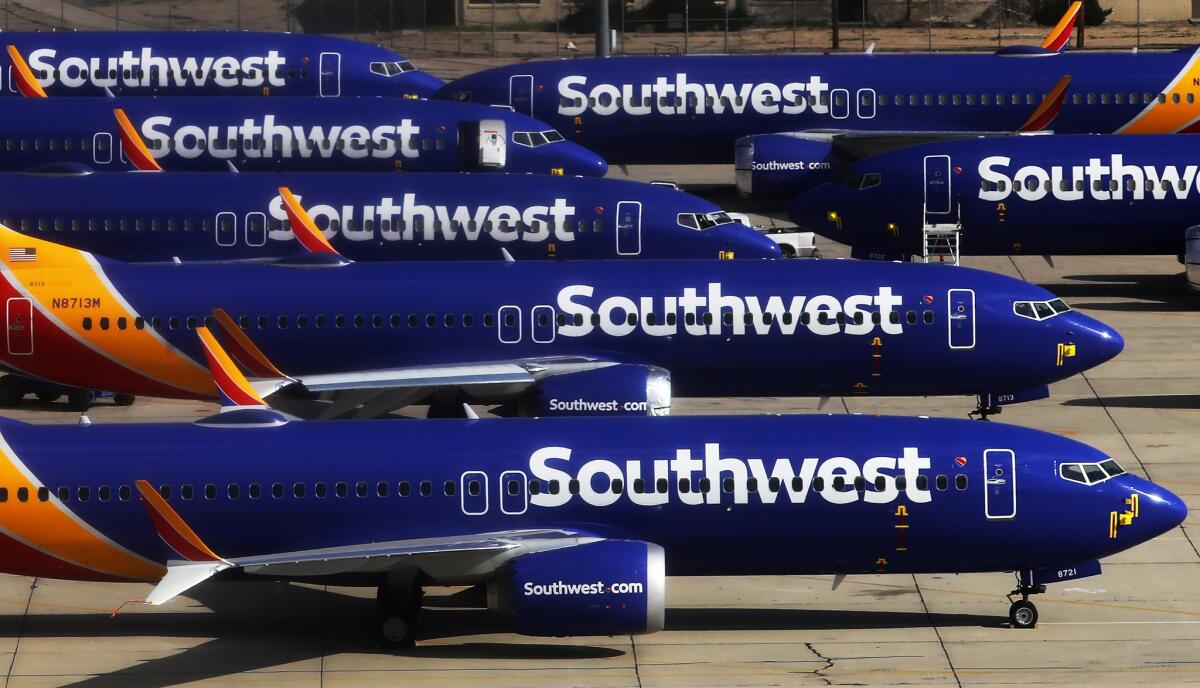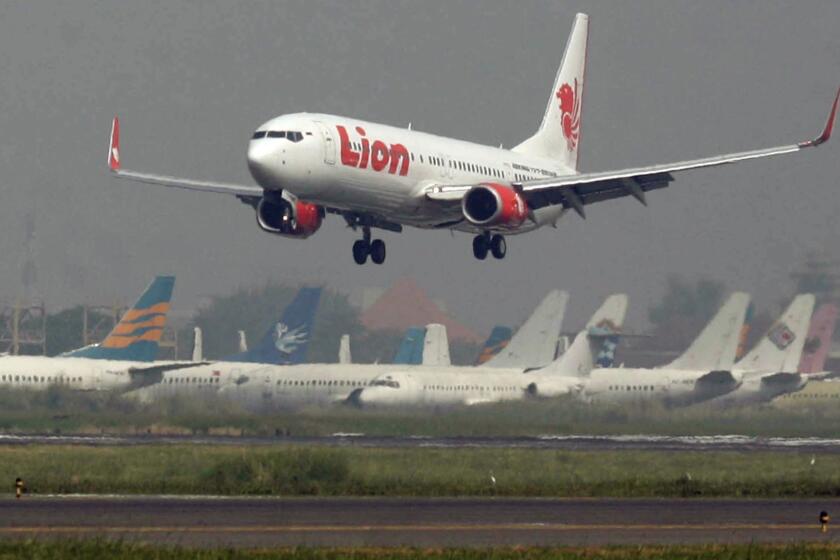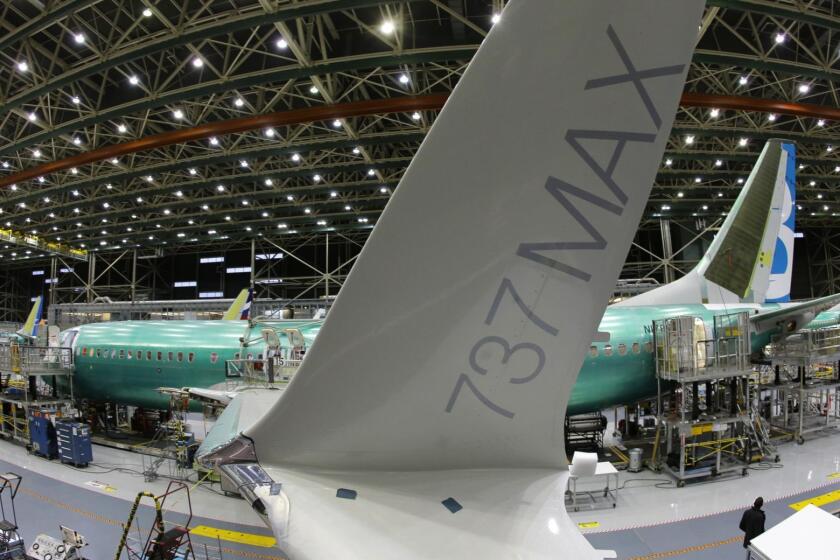Fixing the 737 Max has been hard. Getting people aboard may be harder

Seven months after the second deadly crash of a 737 Max jet, Boeing Co. still is working on software fixes and pilot training to address global aviation regulators’ concerns and get the grounded aircraft back in the sky.
But the Seattle manufacturer and the airlines that bought the plane have another task ahead of them that might be even more difficult: Convincing anxious air travelers that the 737 Max is safe.
Already United Airlines and Southwest Airlines have promised to let passengers who are scheduled to fly in a 737 Max rebook to another plane — without paying a fee — if they feel unsafe in the 737 Max.
Still, the final strategies for easing the nerves of 737 Max passengers remain a work in progress — one the airlines don’t want to discuss.
“We’ll have videos, visuals, FAQs and much more,” said Chris Mainz, a spokesman for Southwest Airlines, which has 34 planes grounded. “But again, our plans aren’t final and we’re just not quite ready to provide specifics.”
Boeing recognizes that airline passengers will be nervous boarding a 737 Max again, the company’s chief executive, Dennis Muilenburg, told a gathering of the trade group Global Business Travel Assn. in August.
“This is certainly a challenging situation and the respect and confidence of the flying public is extremely important to us,” he said. “And we know that trust has been damaged over the last few months and we own that and we are working hard to re-earn that trust going forward.”
When hundreds of 737 Max planes were grounded in March, the process of getting the popular aircraft flying again was predicted to take a matter of weeks. Since then, Boeing has conducted more than 700 test flights of the 737 Max with new software updates and has invited more than 200 pilots to informational sessions with the company, according to Boeing representatives.
Boeing is sticking to its timeline of a return to service for the 737 Max by the end of the year, but some analysts doubt the plane will fly again until 2020. United and Southwest airlines have pulled the 737 Max from their flight schedules until at least December.
American Airlines said Wednesday that it plans to return the plane to service on Jan. 16, more than a month beyond its previous forecast. The Fort Worth-based airline promised to release in the coming weeks its policies and procedures for people who don’t want to fly in the 737 Max.
Boeing and the airlines will have their work cut out for them when it comes time to get airline passengers feeling good about booking flights on the plane.
At least 20% of U.S. travelers say they will definitely avoid the plane in the first six months after flights resume, according to a study led by consultant Henry Harteveldt. More than 40% said they’d be willing to take pricier or less convenient flights to stay off the 737 Max. A separate UBS Group survey found that 70% would hesitate to book a flight on Boeing’s bestselling jet.
The 737 Max was grounded after the crashes of Indonesian Lion Air Flight 610 in October 2018 and Ethiopian Airlines Flight 302 in March. A combined 346 people died in the crashes. There were no survivors from either flight.
A Lion Air flight with 188 people on board crashed into the sea just minutes after taking off from Indonesia’s capital on Monday.
Before the 737 Max was grounded, Boeing had reported more than 5,000 orders for the plane from at least 79 customers. So far, Boeing has delivered fewer than 400 of the planes, most of which are being stored at remote airfields such as the Southern California Logistics Airport near Victorville, where Southwest has parked 34 of the planes.
United Airlines has 14 of the 737 Max jets stored at Phoenix Goodyear Airport, west of Phoenix. American Airlines has 24 737 Max planes that are grounded, 15 stored at Tulsa International Airport and nine at the Roswell International Air Center in New Mexico.
The Federal Aviation Administration has met with international air regulators from China, the European Union, Brazil and Canada, among others, to discuss a software fix and new pilot training that Boeing has been developing to ensure the jets are safe to fly.
The challenge of reintroducing a plane with a questionable safety record is not unprecedented.
In 1979, the DC-10, built by McDonnell Douglas, was grounded for 37 days after a crash near Chicago O’Hare International Airport killed all 271 people on board.
More than a year after the accident, McDonnell Douglas Corp. hired a marketing and communications firm to reassure the flying public about the aircraft. The manufacturer believed that 5% to 10% of travelers had reservations about getting back into the DC-10.
The campaign included television, newspaper and magazine ads featuring former NASA astronaut Charles “Pete” Conrad, who was the third man to walk on the moon. In the ads, Conrad said of the DC-10, “I’m convinced it’s the world’s most thoroughly tested commercial jetliner.”
Although the plane went on to develop other safety concerns that made passengers nervous, including another crash in 1989, the DC-10 continued to fly commercial passengers until 2007. Still, worry persisted, leading American Airlines to rename its DC-10 Luxury Line the less controversial “American Airlines Luxury Liner.”
To regain the trust of future 737 Max fliers, marketing and crisis management experts say, Boeing and airlines need to organize a public demonstration of their confidence in the plane. One academic suggested that Boeing executives fly the plane with their family members and pets on board before the 737 Max is deployed for commercial use.
“I think they have to do something,” said Steve Goldman, who teaches crisis management at MIT. “They really need to go the extra mile.”
Goldman’s idea may sound extreme but the head of the FAA has already vowed to personally fly in the 737 Max before approving it for public use. United Airlines Chief Executive Oscar Munoz made a similar promise.
“All the people in the world have to be assured and made confident that this is an aircraft that’s safe,” he told CNBC last month. “We’ve said from Day One that I would fly the first one on United, but more importantly, that the safety and the security of our employees and customers is paramount.”
It’s not a new idea.
After the 2000 crash of the supersonic Concorde in France, which killed 113 people, British Airways employees were the first passengers in a test flight that was designed to demonstrate the safety of the plane.
But the timing of the flight was awful: The plane landed on Sept. 11, 2001, shortly before terrorists flew hijacked airplanes into New York’s World Trade Center, the Pentagon in Arlington, Va., and a field in Shanksville, Pa. All flights in the U.S. were grounded for three days, generating concerns about airline safety that lingered for years.
Other experts suggest airlines and Boeing take a more reserved approach by first publicly accepting responsibility for the plane’s safety problems and then explaining how the plane has been fixed.
“It’s an overused word but it applies here: They have to be transparent,” said Eric Rose, a crisis management consultant with Englander Knabe & Allen in Los Angeles.
Following two deadly crashes, the U.S. joined the rest of the world in temporarily grounding the Boeing 737 Max, the newest version of one of the most popular planes in the world.
Michael Belch, a marketing professor at San Diego State University, said if he were advising Boeing and the operators of the 737 Max he would recommend that they first try to win the confidence of the pilots who will be asked to fly the planes.
Americans are increasingly distrustful of regulators and government agencies, he said, but passengers would feel safe in the cabin if the pilots in the cockpits expressed confidence in the fixes that were implemented.
“Primarily, you need to get the pilots to say, ‘I’m comfortable with this,’” he said.
Pilots began expressing misgivings about the 737 Max after the first fatal crash, and the Southwest Airlines pilots union on Monday sued Boeing for at least $115 million in lost compensation caused by the grounding and accused the company of putting profits ahead of safety. Boeing said the suit was without merit.
American Airlines already appears to be emphasizing the role of its pilots in reassuring passengers of the safety of the plane. Some of the air carriers’ pilots had voiced their concern about the plane’s automated anti-stall system in a meeting with Boeing after the first crash.
“Once the aircraft is cleared to fly again, American will continue to look at ways to reiterate to our customers that our pilots are the best in the business and would never fly an unsafe aircraft,” American Airlines spokesman Curtis Blessing said. “All of our customers can be assured that an American Airlines pilot would never operate an unsafe aircraft.”
Steve Dahms, a business development expert from San Diego who flies extensively on American Airlines, said he’d be hesitant to board a 737 Max until regulators publicly announce fines and even criminal proceedings filed against Boeing executives who were responsible for the plane’s safety problems.
“Without that information,” he said, “I will feel less than safe.”
More to Read
Inside the business of entertainment
The Wide Shot brings you news, analysis and insights on everything from streaming wars to production — and what it all means for the future.
You may occasionally receive promotional content from the Los Angeles Times.













